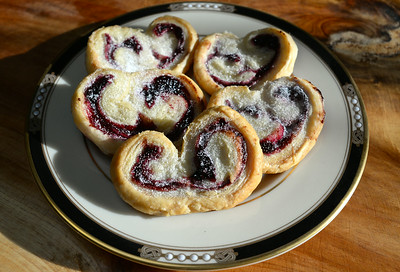
PLATE OF BLACK CURRANT PALMIERS
A few Sundays ago I lucked out and found fresh, plump red and black currants at the Rhinebeck Farmers Market. Unlike the red currants, which I’d churned into sherbet, I took a fairly traditional approach with the larger, purplish-black fruit and cooked up a batch of black currant jelly.
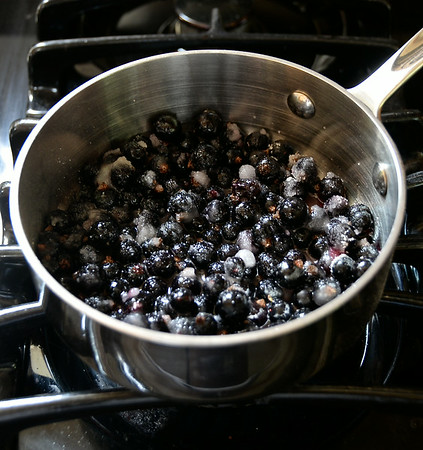
BOILING DOWN THE FRESH BLACK CURRANTS
Why jelly? Like their red relation, black currants contain a large amount of pectin, the substance that causes foods to thicken and gel. To make black currant jelly, I simmered the fruit with some sugar and lemon juice. Once the berries had softened and the sugar had dissolved, I strained the reddish-violet syrup into a glass bowl. I allowed it to cool and set and — voila! — I had black currant jelly.
Because I’d wanted to do more with currants than just make preserves, I came up with a twist on an old family favorite, palmiers. Made from puff pastry, this simple French cookie gets its name from its palm leaf-like shape. Depending on where you live and how you perceive its appearance, you may know this treat as an elephant ear, angel wing or butterfly. Different names. Same sweet.
When I was growing up, my grandmother would make palmiers from leftover dough and granulated sugar, the same ingredients and technique that French bakers had been employing for a century. As elegant as they may sound, palmiers originated in France as a means of using up scraps of puff pastry.
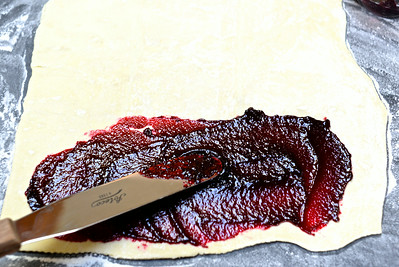
SPREADING THE BLACK CURRANT JAM
In spite of the cookie’s humble origins I’m more likely to buy puff pastry specifically to make palmiers. I also like to dress up the cookies with ground cinnamon, ginger or chocolate or almond paste. Spreading a thin layer of homemade black currant jelly over the puff pastry isn’t much of a stretch.
If you’re come across black currants and decide to make your own jelly for these cookies, you’ll need to follow the Easy Black Currant Jelly recipe.
EASY BLACK CURRANT JELLY
Makes about 1/2 cup
10 ounces black currants
3/4 cup plus 1 tablespoon granulated sugar
1 1/2 tablespoons lemon juice
Place the currants, sugar and lemon juice in a medium saucepan and bring the ingredients to a boil over medium heat. Cook until the berries have softened, the sugar has dissolved and the released juices have thickened, about 10 minutes. Remove from heat and allow the mixture to cool slightly.
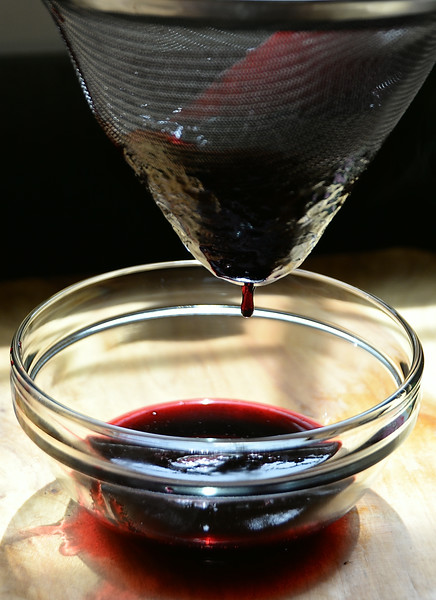
STRAINING THE JUICE FROM THE BOILED BLACK CURRANTS
Pour the berries and juice into a fine mesh strainer placed over a glass bow. Strain the liquid into the bowl. Using a spoon, press down on the berries to ensure that you squeeze out all of their juices. When finished, discard the spent berries.
Allow the syrup to cool to room temperature. Cover the bowl with plastic wrap and refrigerate until the jelly has set completely, at least 2 hours.
BLACK CURRANT PALMIERS
Makes 2 dozen
1 sheet puff pastry, thawed
1/4 cup black currant jelly
2-3 tablespoons granulated sugar
Preheat the oven to 425 degrees F. Line a baking sheet with parchment paper. Lightly dust your work surface with flour.
Place the puff pastry on the flour-covered work surface and roll it out to about 1/8-inch thick. Evenly spread a thin layer of jelly over the pastry.
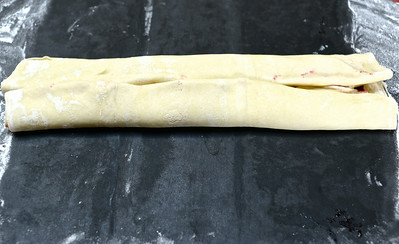
FOLDING THE PASTRY DOUGH
Fold the longer sides of the pastry to the middle of the dough, so that the edges of the two touch. Fold each side to the middle again so that you have the long roll that’s depicted in the photo below. Fold one long side over the other so that you have one long, skinny roll. Cut off the uneven ends and set aside the scraps. You can bake or compost them later.
If you find that the puff pastry seems too soft, refrigerate for 5 to 10 minutes or until chilled and firm. Otherwise, using a sharp knife, slice the pastry into 1/4-inch rounds. Place the rounds on the parchment-lined baking sheet, leaving about an inch between each. As you’re slicing, be sure to wipe off the knife periodically so that your cookies don’t also become jelly-coated instead of just jelly-filled.
Dust the tops of the cookies with the sugar. Bake for 13-15 minutes or until golden and puffed. Cool completely on wire racks before consuming.